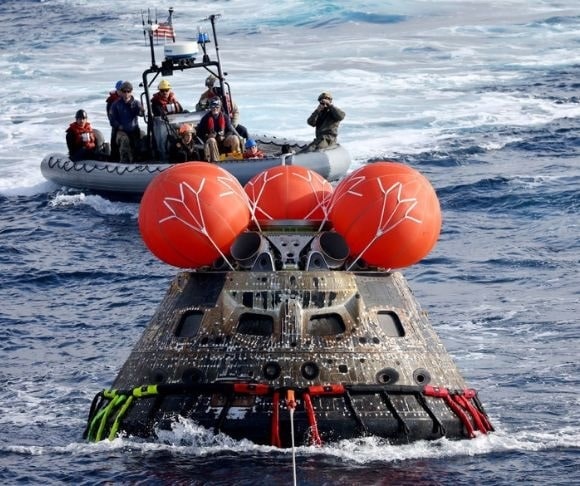Look, up in the sky, traveling at Mach 32 through the atmosphere; it’s Artemis 1 back from its trip around the moon. On Sunday at 12:40 p.m. Eastern Time, Artemis 1’s Orion space capsule gently splashed down off the west coast of Baja, California, after a nearly 26-day mission to the moon and back. The USS Portland that was standing by recovered the space capsule. Earlier in the flight, the Orion capsule separated from the service module at approximately 11:00 a.m. Eastern Time, having been connected throughout the trip to the moon, and returned to Earth. The service module was destined enter and burn up in the Earth’s atmosphere. After a journey exceeding 1.4 million miles, the Orion capsule executed a new atmosphere-entry technique.
 The NASA narrative of the return explained, “…the crew module will perform a skip entry technique, dipping into the upper part of Earth’s atmosphere and using that atmosphere, along with the lift of the capsule, to skip back out of the atmosphere, then reenter for final descent under parachutes and splash down.” The skip entry atmosphere reentry method is also designed to reduce the G-loading on future space crews. The crew module, as the Orion capsule is called, will be manned for future moon trips. But on this mission, there were no humans on board. Nonetheless, the splashdown occurred 50 years to the day of the Apollo 17 moon landing.
The NASA narrative of the return explained, “…the crew module will perform a skip entry technique, dipping into the upper part of Earth’s atmosphere and using that atmosphere, along with the lift of the capsule, to skip back out of the atmosphere, then reenter for final descent under parachutes and splash down.” The skip entry atmosphere reentry method is also designed to reduce the G-loading on future space crews. The crew module, as the Orion capsule is called, will be manned for future moon trips. But on this mission, there were no humans on board. Nonetheless, the splashdown occurred 50 years to the day of the Apollo 17 moon landing.
Artemis 1 Makes a Skip Entry Return
Additionally – not often but occasionally – a returning spacecraft will not be conveniently aligned with the precise location on the earth optimal for splashdown and recovery. With the skip entry, the returning spacecraft can be much more precise in hitting the planned landing spot. “The splashdown occurred more than 300 miles (482 kilometers) south of the original target zone. Forecasts calling for choppy seas and high wind off the Southern California coast prompted NASA to switch the location,” Associated Press correspondent Marcia Dunn explained. The adjustment in the landing site validated the skip entry procedure.

(Pool photo by Mario Tama/Getty Images)
The Orion crew module approached the earth traveling at approximately 25,000 mph, used the earth’s outer atmosphere to decelerate to 325 mph resulting in the friction with the air creating a temperature on the capsule’s outside heat shielding of around 5,000 degrees Fahrenheit or “about half as hot as the surface of the Sun,” NASA explained. From Mach 32 to a splashdown velocity of 20 mph is heavy on the brake pedal.
The Artemis 1 mission was historic, performing a deep space profile and taking a man-capable spacecraft further than any previous space flight. “Meanwhile, the Orion craft will make a low flyby of roughly 60 miles above the moon’s surface,” explained Liberty Nation’s coverage of the Artemis 1 mission profile, “and then move to a position nearly 40,000 miles beyond the moon, taking up what NASA calls a distant retrograde orbit.” On the way to the moon, one of the spacecraft’s rocket propulsion stages, the Cryogenic Propulsion Stage (ICPS), had its own tasks. Liberty Nation described in an earlier article:
“The ICPS continued on a course similar to Orion’s after separation but includes the task of deploying ten small 4X4X4-inch satellites. The satellites — called Cubesats — will take up their discrete tracks to the Moon to perform various experiments and demonstrations. The Cubesats may remain to make more in-depth studies of the Moon or be diverted to gather data for future NASA deep space exploration.”
Artemis Missions Have a Bright Future
In the coming months, NASA analysts will have their hands full, assessing the host of photos of the moon’s surface and looking back at the Earth from space. The space agency workers got a treat, “As a parting shot, the capsule revealed a crescent Earth — Earthrise — that left the mission team speechless,” AP reported.
The next Artemis mission will carry a human crew for one more moon orbiting mission. Reports are that NASA will announce the four Artemis II crew members in six months. The launch of Artemis II will occur sometime in 2024. Then the plan is for Artemis III to return to the moon for a lunar landing in 2025. Once again, the US leads in space exploration. Americans can look with pride at this achievement.
The views expressed are those of the author and not of any other affiliation.




